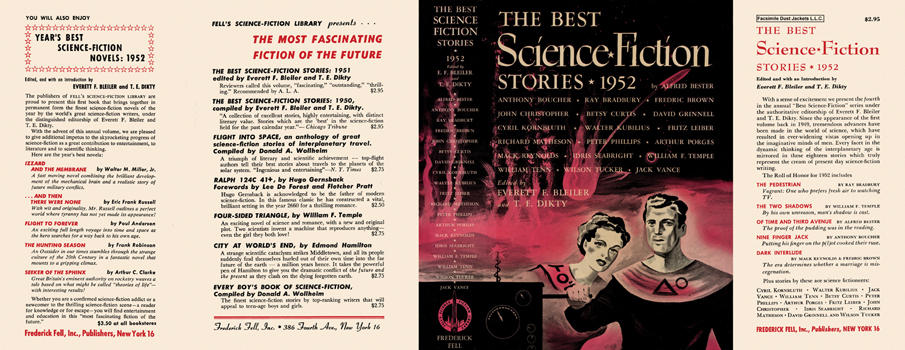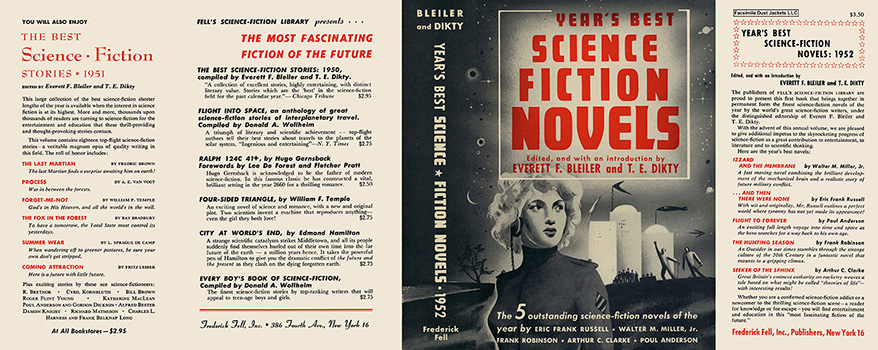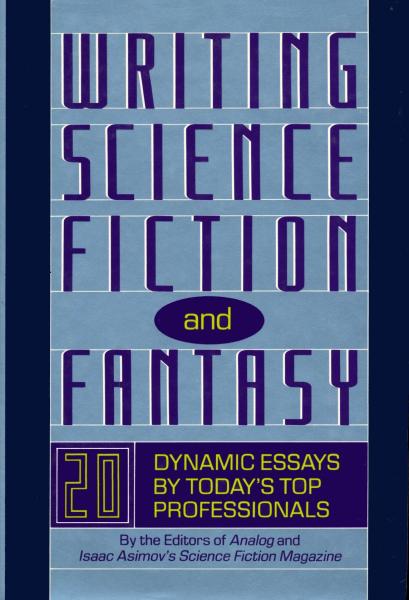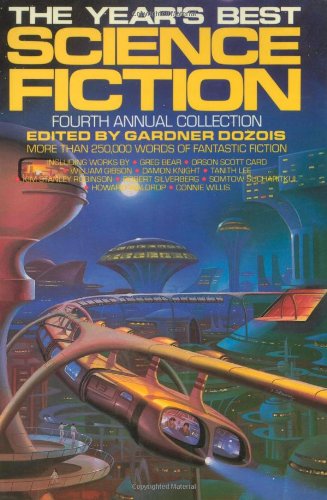
I was struck by the fact that none of these “Best” stories came from Astounding Science Fiction. This breaks a string of Astounding stories from 1949, 1950, and 1951 that were included in Bleiler & Dikty’s previous YEAR’S BEST SCIENCE FICTION volumes. Also, various “new” SF magazines like Worlds Beyond and New Worlds are now represented. By 1951, the SF publishing landscape was changing. This volume includes C. M. Kornbluth’s “The Marching Morons” about a future when the average IQ is 45. Fredric Brown and Mack Reynolds shocked the SF field with their “Dark Interlude.” Time travel plays a role in several of these stories. My favorite is “Of Time and Third Avenue” by Alfred Bester with its clever ending. Anthony Boucher’s fabulous “Nine-Finger Jack” shows how to defeat a Venusian invasion. Jack Vance’s “Men of Ten Books” explores the positives and negatives of motivation on a societal level. GRADE: A
TABLE OF CONTENTS:
Introduction (The Best Science-Fiction Stories: 1952) – (1952) – essay by Everett F. Bleiler and T. E. Dikty 7
The Other Side – (1951) – shortstory by Walter Kubilius (SUPER SCIENCE STORIES, April 1951) 21
Of Time and Third Avenue – (1951) – shortstory by Alfred Bester (The Magazine of Fantasy and Science Fiction, October 1951) 38
The Marching Morons – (1951) – novelette by C. M. Kornbluth [as by Cyril Kornbluth] (Galaxy Science Fiction, April 1951) 47
A Peculiar People – (1951) – shortstory by Betsy Curtis (The Magazine of Fantasy and Science Fiction, August 1951) 81
Extending the Holdings – (1951) – shortstory by Donald A. Wollheim [as by David Grinnell] (The Magazine of Fantasy and Science Fiction, April 1951) 97
The Tourist Trade – (1951) – shortstory by Wilson Tucker (Worlds Beyond, January 1951) 102
The Two Shadows – (1951) – novelette by William F. Temple (Startling Stories, March 1951) 113
Balance – [Max Larkin] – (1951) – shortstory by John Christopher (New Worlds, Spring 1951) 140
Brightness Falls from the Air – (1951) – shortstory by Margaret St. Clair [as by Idris Seabright] (The Magazine of Fantasy and Science Fiction, April 1951) 159
Witch War – (1951) – shortstory by Richard Matheson (Startling Stories, July 1951) 166
At No Extra Cost – (1951) – shortstory by Peter Phillips (Marvel Science Stories, August 1951) 172
Nine-Finger Jack – (1951) – shortstory by Anthony Boucher (Esquire, May 1951) 190
Appointment in Tomorrow – (1951) – novelette by Fritz Leiber (Galaxy Science Fiction, July 1951) 196
The Rats – (1951) – shortstory by Arthur Porges (Man’s World, February 1951) 225
Men of the Ten Books – (1951) – shortstory by Jack Vance (variant of The Ten Books) (Startling Stories, March 1951) 235
Generation of Noah – (1951) – shortstory by William Tenn (Suspense, Spring 1951) 258
Dark Interlude – (1951) – shortstory by Fredric Brown and Mack Reynolds (Galaxy Science Fiction, January 1951) 271
The Pedestrian – (1951) – shortstory by Ray Bradbury (The Reporter, August 7, 1951) 280
About the Authors (The Best Science-Fiction Stories: 1952) – (1952) – essay by uncredited 286
















